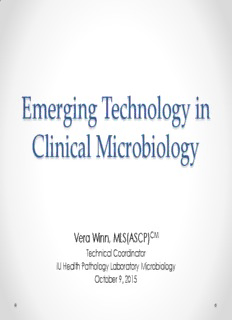
Emerging Technology in Clinical Microbiology - APIC Indiana PDF
Preview Emerging Technology in Clinical Microbiology - APIC Indiana
Emerging Technology in Clinical Microbiology Vera Winn, MLS(ASCP)CM Technical Coordinator IU Health Pathology Laboratory Microbiology October 9, 2015 Disclosures • No financial or research relationships to disclose 2 Backgrounds • “Imported” from Taiwan in 1998 • An island in eastern Asia (Mandarin Chinese) • Cases of Dengue Fever multiply in S. Taiwan 3 Backgrounds • Indiana University Health Pathology Laboratory • Centralized testing facility • IU Health University Hospital • IU Health Methodist Hospital • Riley Hospital for Children at IU Health • Numerous other IU Health and non-IU Health hospitals in Indiana • Numerous IU Health and non-IU Health clinics and physician’s offices • 12 - 14 million laboratory tests per year 4 Objectives • Identify and describe commonly concerned organisms that are related to healthcare- associated infections • Describe the differences between traditional methods and molecular methods for clinical microbiology testing • Describe the latest molecular technology in clinical microbiology 5 5 Moments of Hand Hygiene World Health Organization 6 The “Big Players” Abbrev. Full Name VRE Vancomycin-resistant Enterococcus MRSA Methicillin-resistant Staph. Aureus ESBL Extended-spectrum β-Lactamases CRE or Carbapenem-resistant CP-CRE Enterobacteriacea or Carbapenemase- producing CRE C diff Clostridium difficile TB Mycobacterium tuberculosis Influenza Human influenza viruses A, B, and C 7 ESBL • First discovered in Europe in the mid 80s • GN bacteria, mostly Enterics such as E. coli, K. pneumoniae, & K. oxytoca • Produce enzymes, Extended Spectrum Beta- Lactamases, breaks down and destroys: o Penicillins o Expanded-spectrum cephalosporins (Cefotaxime, Ceftriaxone, and Ceftazidime) o Oxyimino-Monobactam Aztreonam Treatment failure 8 ESBL • Derived from many plasmid encoded genes, such as TEM, SHV, CTX-M, OXA o Transferable—Plasmid transfer bacterial resistance • Diagnose challenges: o Current best method still relies on traditional culture and susceptibility test o Many genes o Compete for attention • Limited treatment options: o Nitrofurantoin o Fosfomycin (UTI only) o Chloramphenicol o For serious infections: Carbapenem (Ertapenem) or gentamicin injections 9 CRE or CP-CRE • What are carbapenem antibiotics available in the US? o Primaxin (Imipenem, Merk, 1985) o Merrem (Meropenem, AstraZenica, 1996) o Invanz (Ertapenem, Merck, 2001) o Doribax (Doripenem, Johnson & Johnson, 2007) o All 4 drugs are injectable (IV) only o Broad-spectrum: active against GP, GN, anaerobes, non-fermenters o Drugs of choice for severe ESBL infections 10
Description: